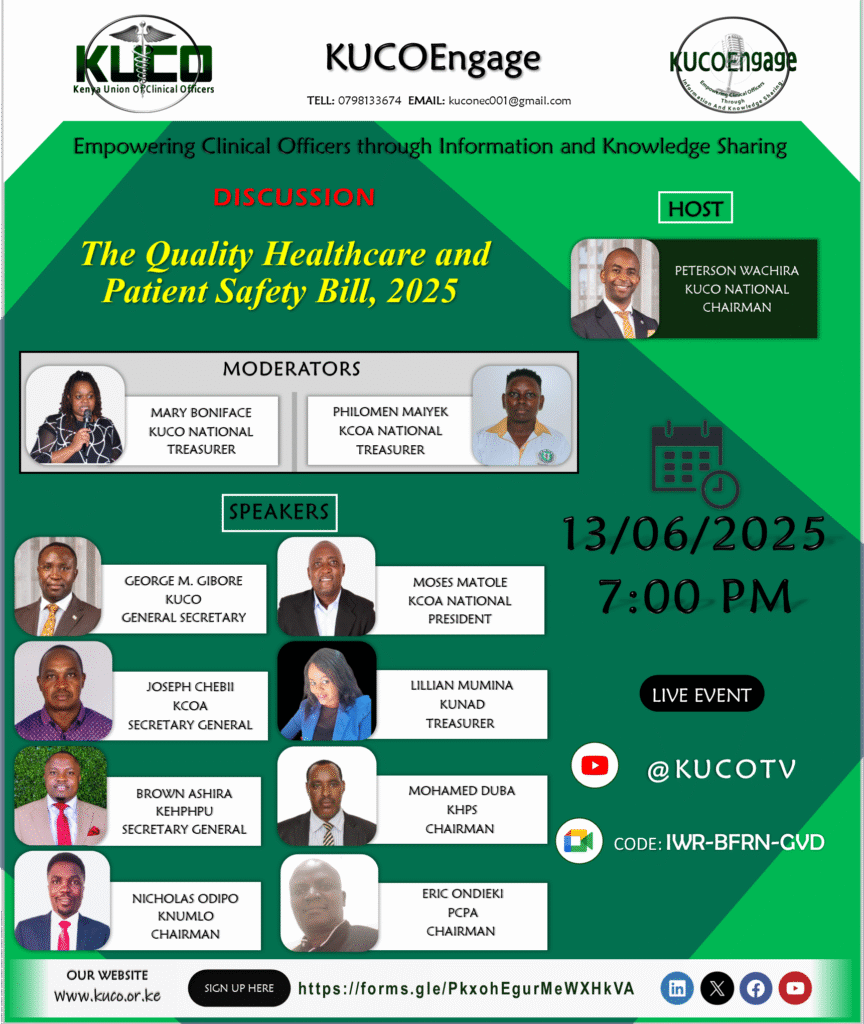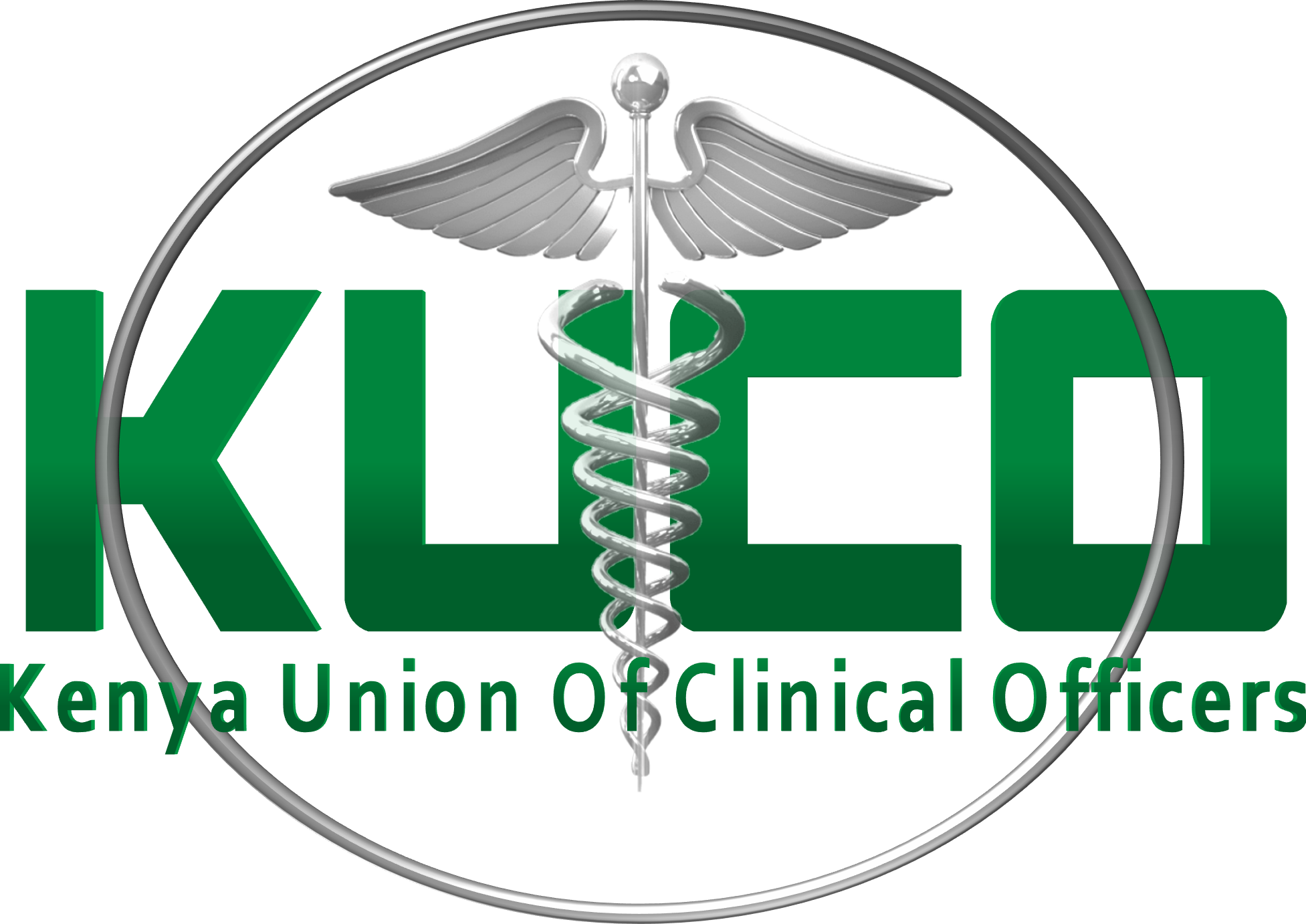NAVIGATING THE DRAFT QUALITY HEALTHCARE AND PATIENT SAFETY BILL, 2025:

A CALL FOR UNITY AMONG HEALTHCARE PROFESSIONALS.
On June 13, 2025, the Kenya Union of Clinical Officers (KUCO) hosted #KUCOEngage Episode 6 (part 1), the first of 2 segments that aired for the first time in the month of June. It was a crucial meeting to dissect the proposed Draft Quality Healthcare and Patient Safety Bill, 2025.
This gathering brought together various healthcare professionals and union leaders, including representatives from the Private Clinical Practitioners Association, Kenya National Union of Medical Laboratory Officers, Kenya Health Professionals’ Society, Association of Public Health Officers Kenya, and the Kenya Union of Nutritionists and Dieticians. The overarching theme of the discussion was the potential impact of this bill on healthcare practice and regulation in Kenya, with a strong emphasis on the need for unity among all healthcare workers.
Understanding the Bill: Key Provisions and Concerns
Peterson Wachira, the National Chair of KUCO, led the initial presentation, outlining the bill’s key provisions. The bill aims to give effect to Article 43(1)(e) of the Constitution, focusing on quality healthcare for patients. It proposes the establishment of a Quality Healthcare and Patient Safety Authority, responsible for regulating, licensing, and accrediting health facilities, setting standards for quality healthcare, and enforcing compliance.
However, the discussion quickly highlighted significant concerns among the participants. A major point of contention was the extensive replication of content already present in existing legislation, such as the Health Act 2017 among others. Many felt the bill was an “omnibus” designed to consolidate various sections of other acts rather than addressing a clear gap in the healthcare system.
Duplication of Roles and Weakening of Regulatory Bodies
Mohamed Duba, Chairman of the Kenya Health Professionals’ Society, vehemently argued that many of the bill’s provisions, including patient rights and safety, could be addressed through amendments to existing laws like the Health Act 2017 and the Pharmacy and Poisons Act. He, and others, expressed concern that the establishment of a new authority would render existing regulatory boards “extensile” and create unnecessary parastatals at a time when the government is discussing collapsing existing ones due to funding issues.
Brown Ashira, representing the Kenya Environmental Health and Public Health Practitioners, echoed these sentiments, emphasizing that Kenya does not lack laws to govern its healthcare sector. He highlighted the Public Health Act, first enacted in 1921, as a robust example of existing legislation. Ashira questioned the rationale behind introducing new acts that duplicate roles and undermine the established functions of different healthcare professionals. He stressed the need to strengthen existing acts rather than introducing new, potentially confusing, legislation.
Centralization of Power and Lack of Professional Representation
A significant concern revolved around the proposed Quality Healthcare and Patient Safety Authority’s structure and powers. Peterson Wachira noted that the bill centralizes the responsibilities of facility registration, licensing, and accreditation, traditionally handled by various regulatory bodies, under this single authority. This raised questions about the effectiveness of such a centralized system, particularly regarding quality assurance mechanisms.
Moses Konde, President of Kenya Clinical Officers Association, pointed out that clauses 27 and 28 of the bill, which establish the authority, would lead to “regional overlap and regulatory conflict.” He also highlighted that clauses 21 and 22 empower the authority and the Cabinet Secretary (CS) through the Director General (DG) to develop national clinical protocols and determine standards of care, effectively placing the “scope of practice” under the DG’s mandate. This is seen as a critical threat to the autonomy of professional regulatory bodies, which currently handle such matters with input from diverse experts.
Furthermore, concerns were raised about the composition of the proposed board of directors for the authority. Several speakers, including Moses Konde, pointed out a “lack of representation” for many healthcare professionals, suggesting that decisions affecting their practice would be made by a board with limited direct input from their respective fields. George Gibore, the General Secretary of the Kenya Union of Clinical Officers, highlighted the danger of a bill “taking away the mandate from an institution [and putting] it in the hands of individuals who have made statements publicly even against other cadres with the goal of demeaning them.” He stressed that the position of a Director General is an individual one, susceptible to individual bias and negative views.
The “Good” the “Bad” the “Bill”: A Contrasting Perspective
While the overwhelming sentiment in the meeting was one of opposition, a contrasting perspective was offered by Oduor Otieno. He argued that there was indeed a “gap” in the current system, particularly regarding the accreditation of health facilities and the oversight of patient safety. Otieno suggested that existing regulatory bodies, such as the Clinical Officers Council (COC) and the Kenya Medical Practitioners and Dentists Council (KMPDC), are “not well equipped to even regulate the practice of healthcare in these facilities” when it comes to comprehensive patient safety and quality improvement.
He emphasized the need for a “standalone oversight authority” for patient safety and quality improvement, citing global practices in the aviation industry as an example where an independent body investigates incidents. Otieno also highlighted the potential benefit of “one license” for facilities, meaning a single accreditation for a health facility, regardless of the professions operating within it. He argued that this would streamline processes and potentially improve quality by applying uniform standards.
Despite this perspective, Otieno acknowledged the bill’s “misses,” such as its lack of clarity on how to investigate patient harm incidents of significant magnitude. He concluded that while the bill has both “hits and misses,” it requires further strengthening and refinement.
A Unified Front: The Call to Action
The consensus among most participants was a strong rejection of the bill in its current form. Mohamed Duba and Brown Ashira explicitly stated their unions’ opposition and called for a “total rejection.” Eric Ondieki, Chairman of the Private Clinical Practitioners Association, labeled it a “dangerous bill” that would lead to “a lot of confusion.” He urged all healthcare professionals to “step forward and take this bull by the horns” by actively participating in the upcoming county-based public participation forums from June 24th.
Lilian Mumina, National Treasurer of the Kenya Union of Nutritionists and Dieticians, emphasized that the bill, despite its title, is not genuinely aimed at “patient protection” but rather at “ensuring dominance in the health sector.” She called for “awareness campaigns” to educate the public on why the bill is detrimental.
Joseph Chebii, Secretary General of the Kenya Clinical Officers Association, reiterated the view that the bill is “draconian” and has a “pre-planned agenda” to consolidate power and undermine regulatory bodies. He stressed the importance of a “joint talk” and a unified “memo” from all healthcare professional organizations to present a strong, consistent position during the public participation phase.
Conclusion
The meeting served as a crucial platform for healthcare professionals to voice their concerns and unite against The Draft Quality Healthcare and Patient Safety Bill, 2025. The overwhelming sentiment was that the bill, in its current form, is redundant, threatens the autonomy of existing regulatory bodies, centralizes power, and lacks adequate representation for various healthcare cadres. While one dissenting voice highlighted potential benefits related to patient safety oversight, the collective call was for a robust, unified rejection of the bill. The coming public participation forums are seen as a critical opportunity for healthcare workers to stand together and advocate for a healthcare system that genuinely serves the interests of both patients and professionals.


https://shorturl.fm/rieT8
https://shorturl.fm/JM6LB
https://shorturl.fm/2LJeO
https://shorturl.fm/OStpQ
https://shorturl.fm/5Q7HI